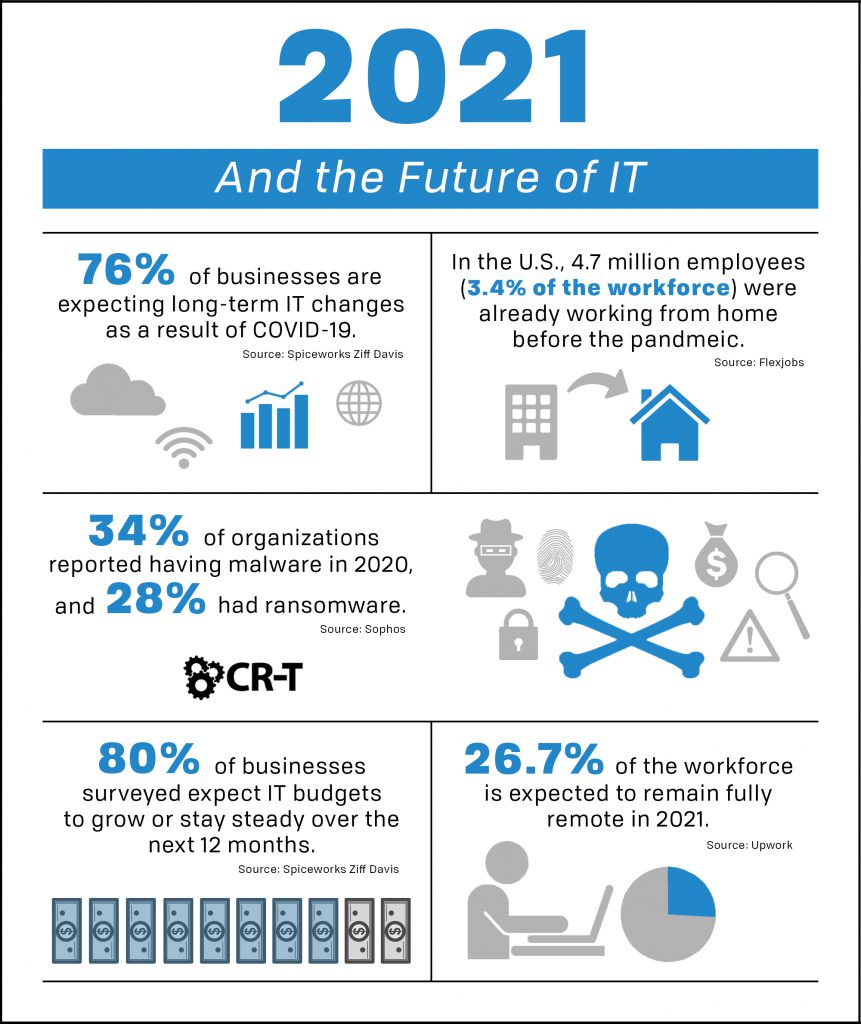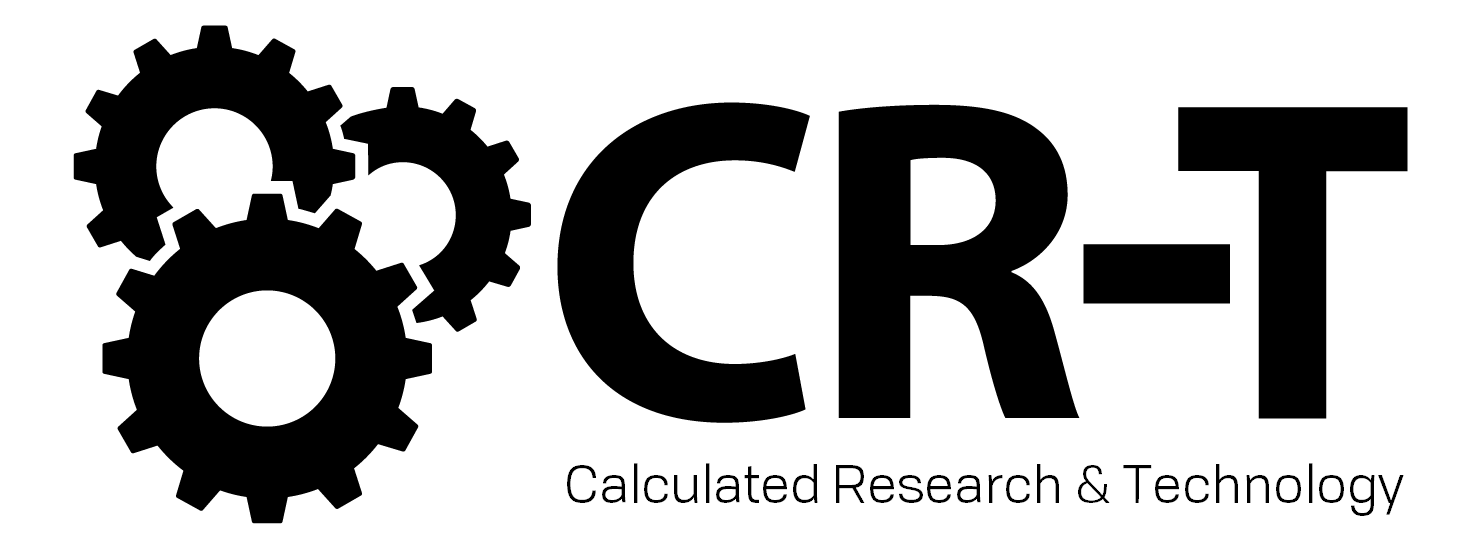It’s not a secret that many companies are relieved 2020 is over. The COVID-19 pandemic forced hundreds of businesses to close, and more employees than ever have returned home to work remotely. As an IT leader, you might feel apprehensive about the year ahead. But there are several things you can do to prepare your department for what’s to come.
To help you get started, here are eight of the top challenges you’re likely to face in 2021, along with tips on how to handle each situation.
1. Guiding Your Company’s Return to the Workplace
- Employees who will return to work onsite full time
- Employees who will continue to work remotely
- A hybrid model of workers who split their time between working onsite and working remotely
2. Securing a Hybrid Workplace
Remote and hybrid work models come with a lot of flexibility, but they can be tricky to manage on a cybersecurity front.
IT leaders will face the unique challenge of keeping company data secure, regardless of where the workforce is. At the same time, IT departments should do this in a way that won’t cause employees to feel held back or like someone is watching them.
Here are a few guidelines for keeping both your onsite and remote work environments secure:
- Restrict which equipment and data can be accessed from home offices.
- Ensure that all company-owned devices are properly labeled.
- Set up remote wiping of hard drives for all company-issued devices, including smartphones, tablets, and laptops.
- Enable Multi-Factor Authentication (MFA) and end-to-end encryption.l
- Avoid automatic logins via a web browser. Instead, use a password manager.
- Don’t use work devices to access non-work-related sites or applications.
3. Reversing the Remote Work Landscape
In the U.S., 4.7 million employees were working from home before the pandmeic, which makes up 3.4% of the workforce (source: Flexjobs).
But as of April 2020, PR Newswire reported that nearly two thirds of employees were working remotely.
That’s a huge jump that’s required employers to change tactics and create more flexibility for remote workers.
Now that we’re nearly a third of the way through 2021, IT leaders need to be prepared for supporting more remote workers than they have in the past. Even though a lot of companies will return to the office this year, it’s expected that almost 30% of the workforce will remain fully remote (source: Upwork).
In order to sustain a long-term remote work model, IT leaders will need to change the way they handle their company’s tech. This includes isolating employees’ work environments from their personal ones while protecting sensitive data from potential threats. It will also involve offering remote support so that employees’ remote work environments can operate seamlessly.

4. Preparing for the Transition to Digital Business Models
In addition to the shift from in-person to remote work, IT leaders will also need to be ready to respond to the constant changes in technology.
Every year, more businesses are migrating to the cloud. Artificial Intelligence (AI) and machine learning are playing a greater role in companies’ day-to-day operations. Blockchain is revolutionizing security in countless fields.
As the world becomes more digital, your IT team will be more valuable than ever to your organization’s evolving landscape.
5. Reevaluating Your IT Budget
COVID-19 changed priorities for a lot of businesses, as teams prioritized video conferencing over in-person meetings and remote work over office attendance.
As office environments begin to shift back to pre-COVID operations, company executives will need to decide which investments are worth making. For example, will it be profitable to continue subscriptions like Slack and Zoom, will AI play a role in your company’s growth, or is it time for your organization to migrate to the cloud?
As a leader in IT, you can add valuable insight to these decisions and support your organization’s employees through new technology.
6. Maintaining 24/7 Uptime
The COVID-19 pandemic opened a lot of eyes to the importance of a reliable network.
Clients expect that their systems will remain available 100% of the time, which can be a difficult demand for some IT departments to meet.
As you shift your business operations to a more remote or hybrid infrastructure, prioritize maintaining 24/7 uptime for your clients and employees. Your attention to detail will help you gain greater trust from your clients and increased rapport within your organization.
7. Battling Burnout
Even during a normal year, IT workers deal with frequent high-stress decisions and countless problems to solve. And after a demanding year of responding to COVID-19, IT departments are experiencing more work fatigue than usual.
IT leaders need to be proactive in supporting their employees and recognizing their colleagues’ needs.
Start by creating a support system that encourages collaboration and teamwork. In addition, regularly check in with employees to ensure they’re prioritizing their own personal and mental health.
8. Balancing Safety and Innovation
If COVID-19 has taught us anything, it’s that failing to prioritize employee safety can have major consequences down the road.
Even after COVID-19 vaccines have been widely distributed, it’s still important for you to maintain a safe working environment and value employee health.
Keep tabs on your employees by giving them the information they need to stay healthy, and provide them with any necessary support.
In addition, IT leaders can play a key role in establishing technologies that seamlessly integrate remote workers with employees in the office.
IT Leaders Can Revolutionize the Workforce this Year.
2020 left many of us feeling intimidated and fatigued, but that doesn’t mean we can’t turn things around in 2021.
As an IT leader, you have a critical role in utilizing technology to support your team and improve your organization.
By preparing for the challenges ahead, you’ll be even more capable of revolutionizing the workforce this year.
Here at CR-T, we take pride in providing enterprise-level IT services at prices that work for small businesses. Our team of experts can become your IT support department, responding to issues quickly, often before you even know about them. Covering everything from your servers and network infrastructure to your computers, workstations and mobile devices, we provide end-to-end solutions for all your technology needs.
Time and experience have helped us develop best practices and workflow procedures designed to keep your focus on your business, not your technology.
Blog & Media
Cloud Services
Managed IT Support
Cyber Security
Project Services
Servers/Infrastructure
Firewalls
Networking
Hardware/Software
Microsoft Products/Cloud
Amazon Web Services
Penetration Testing vs Vulnerability Scanning
If you’re responsible for managing the security of your organization’s network or systems, you may have heard the terms “penetration testing” and “vulnerability testing” thrown
Backup and Disaster Recovery
Your organization can’t afford to neglect backup and disaster recovery. If it takes your business too long to get back online after a disaster, you
6 Steps to Secure Customer Data
Securing customer data is essential for one major reason: your business depends on it. As an IT director, you recognize the importance of cybersecurity when
5 Steps to Promote Compliance in the Workplace
You’re familiar with the ever-changing world of regulatory compliance. Robust compliance enables you to avoid legal liabilities while improving your organization’s effectiveness. And many of






